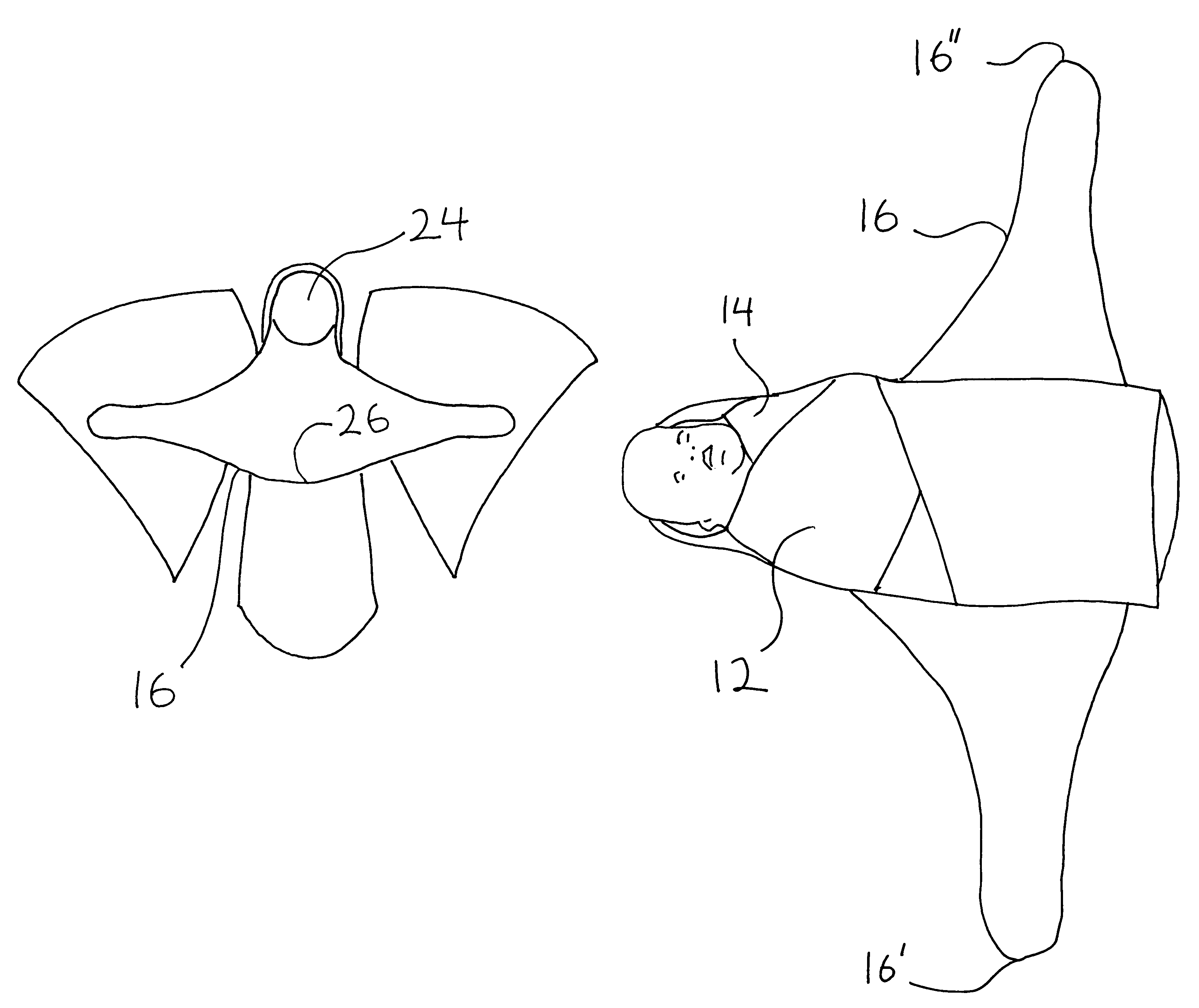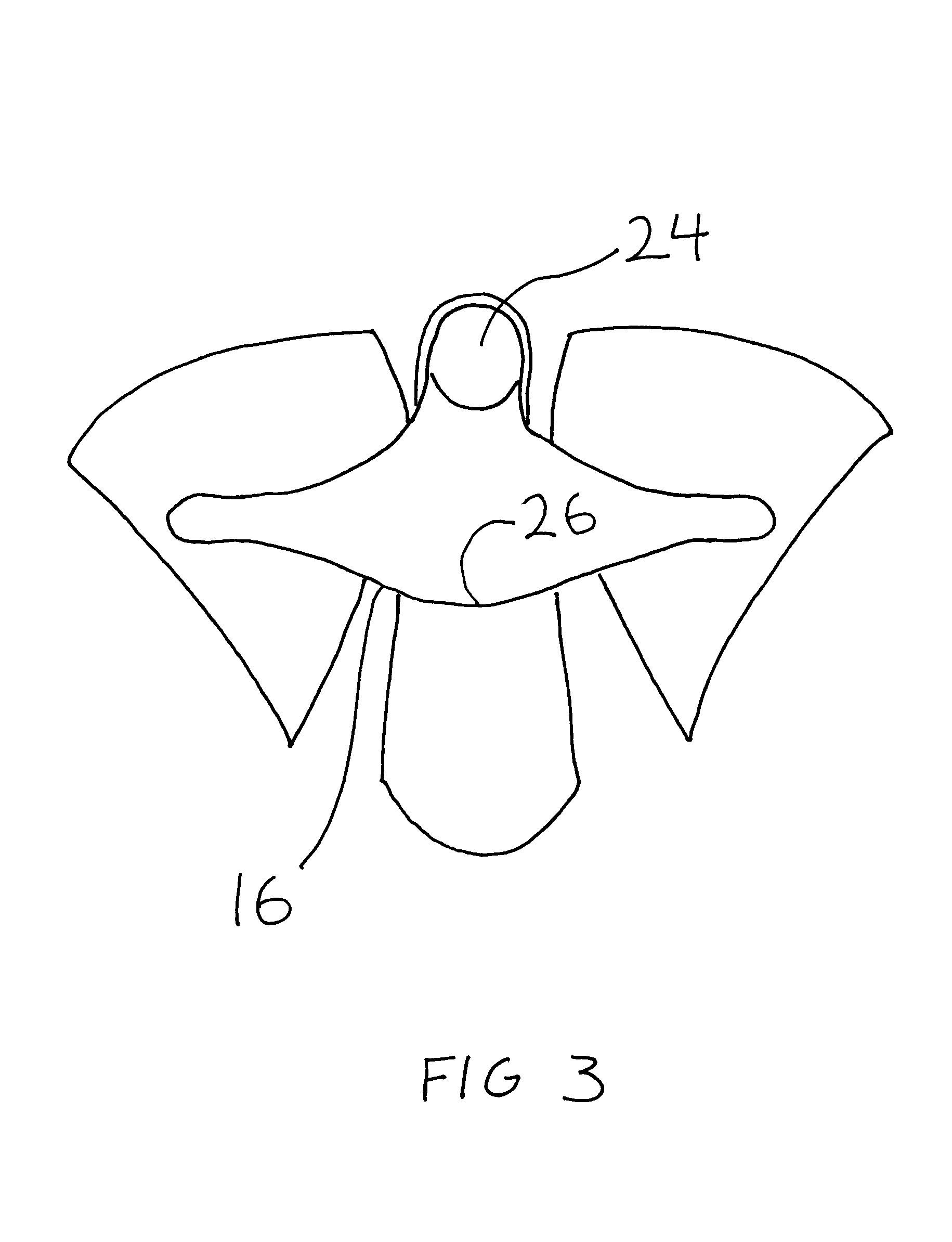A mother with a newborn is typically exhausted from the delivery, increased
workload, increased responsibilities and the decrease of valued sleep.
Trying to swaddle the infant with a receiving blanket while he is
crying can be frustrating.
It is difficult and
time consuming to achieve the desired tight bundle.
Once the infant is swaddled, the blanket often quickly becomes loose or unraveled due to transporting the infant or by the infant's own movements.
Some babies can turn on their stomachs increasing the risk of suffocation.
Each of these fasteners presents problems.
For example, the zipper cannot achieve the tightness needed for a secure feeling nor does it allow for needed size adjustments.
Velcro is noisy and while attempting to adjust the blanket to infant's size for the needed tight fit, can awaken and startle a sleeping infant, contrary to the desirable aspects of the swaddle method.
Velcro does not appear to wear well as infant blankets need frequent washings and Velcro attaching mechanism is reduced with time and use.
Pockets are difficult to slide a limp infant into and when wrapped, smaller infants may not fit correctly into the pockets and larger infants may find the pockets restraining their feet.
Buttons are difficult to fasten when a baby is squirming and
crying and require excessive time.
Snaps require the use of pressure against an infant's body and do not allow for accurate
size adjustment or snug fit.
They can also be noisy.
Another problem noted is that other attempts at creating a blanket wrap use too much fabric extension and make it necessary for a parent to roll the infant several times to make the blanket fit.
Still other blanket wraps use a special
cut design that conforms to the infant's body but may become unraveled resulting in baby kicking off the wrap, turning on their tummies and having a risk of suffocation.
Other attempts at creating a blanket wrap fail to use the traditional swaddle method and appearance and do not provide for the needed, extra snug fit around the infant's legs.
Blanket wraps already created do not include the option for infants to keep their hands out of the blanket with ease while still allowing for blanket to stay snug.
Some blankets are not designed to conform around the shoulders, use an excessive amount of fabric, are uncomfortable and messy.
Another problem noted is that some blankets do not have a slight hammock design that would allow for more space around the bottom and increase comfort.
Another problem noted is that other blankets do not have added fabric around and behind the
head and neck.
Another problem noted is that other blanket wraps do not fit babies from premature size to larger sized infants, e.g., up to three months of age.
Another problem noted is that other blankets may not use 100% cotton, which is lightweight and natural to prevent infants from overheating.
Receiving blankets require taught skill to achieve the swaddle method, become unraveled with infant movement or transport and are a challenge to swaddle when the infant is crying, which increases
frustration for both the infant and the person attempting to swaddle the infant.
Other infant wraps are very expensive.
Other wraps have failed to achieve a design that can conform to an infant's body and allow a secure / snug fit without the use of fasteners or pockets.
Other wraps do not allow for the option to have the infant's hands out of blanket.
Other wraps do not allow for needed size adjustments without the use of added fasteners.
Other wraps fail to have the traditional appearance and the traditional method of swaddling and look like straight jackets.
Other wraps do not allow for a large variety in one-size fits all that include premature infants.
Other wraps are not designed to slightly hammock for increased comfort and appropriately fitting babies body for a non-bulky snug, secure wrap.
Up to date, many attempts have been made to eliminate the problems that a simple rectangular blanket create, however, the attempts, as hopeful and promising as they seem, have failed to solve all of the problems, only touching one or two areas of concern.
This is due to design, for it requires the
elimination of excess folds, unraveling, loose fit, unsafe use of cords / ribbons, pockets and the use of inconvenient fasteners.
The prior art is complicated, does not uniformly hug the infant, are not as fast and are expensive.
Because of the expense, complicated design and failure to solve the problems that have been presented for hundreds of years, one fails to see a swaddle blanket sold regularly, as a needed accessory, for every infant, on the market when swaddling has been reported as an infant necessity and can relieve colic, reduce risks of Sudden Infant Death Syndrome and improve the
quality of life and emotional well-being of the infant and the parent.
 Login to View More
Login to View More  Login to View More
Login to View More 


